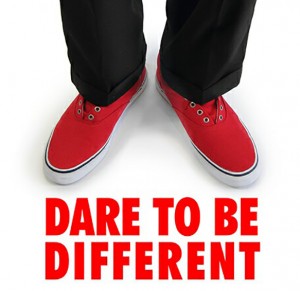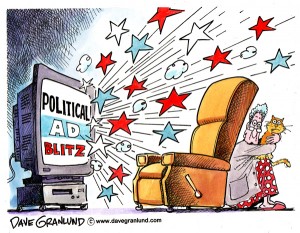Rolf Gutknecht is vice president, director of account services for LA ads. To discuss your thoughts with Rolf on this blog or any marketing matters, email via this link, or visit www.LAadsMarketing.com. You can also connect with Rolf on LinkedIn.
 There’s a traditional Japanese proverb that says “The nail that stands out is quickly hammered down.” For generations, conformity has been a societal standard in Japan.
There’s a traditional Japanese proverb that says “The nail that stands out is quickly hammered down.” For generations, conformity has been a societal standard in Japan.
The funny thing is, it’s not that different in American business. More companies, large and small, are comfortable looking like all the others and doing things the way they’ve always been done. Breaking away from tradition is something one dare not do for risk of offending someone, or making the folks in the back offices uncomfortable.
To that, I say, Poppycock, balderdash, bull-pucky!
Every once in a great while, I’ll see some marketing effort that is truly exceptional, even edgy – and I’ll contact the marketer and ask about the results. Almost all tell me that the effort was successful and helped them stand out in their marketplace.
Do they get complaints? Yes, some…but mostly they get new business, so it’s worth the risk. And this has also been our experience. When an advertiser Dares to be Different, they get noticed, and sales commonly start to follow. Which is why our own motto, Dare to be Different, has been on our lips since we began in the 1990s.
And the funny thing is, it doesn’t take much to be different and get noticed.
Take our Red Shoes, which we always wear to conventions. You might say it’s our walking trademark, but really, it’s just our putting our own philosophy where our feet are.
People we’ve never met, never spoken with, stop us as we walk down the aisles wanting to know about our red shoes. When we walk along the booths, we’re always noticing how people’s eyes suddenly dart downward to our shoes and they smile. Friends will see us all the way across the hall because our red shoes stand out, even in a crowd. We even had one guy tell us, “I’ve now seen you walking down this aisle four times – but I never noticed anyone else!”
All this from just wearing a pair of red shoes. What does that tell you?
Different is visible. Different is memorable. Different is interesting.
So, the question is… will you Dare to be Different to capture attention and get new business? Or is your own comfort zone holding you back? As I always like to say, if you don’t know the answer to this, your audience certainly does.
####
Dan Katz is president, creative director of LA ads. To discuss your thoughts with Dan on this blog or any marketing matters, email via this link, or visit www.LAadsMarketing.com. You can also connect with Dan on LinkedIn. See agency work via this link.
 “Life can only be understood backwards; but it must be lived forwards.” – Soren Kierkegaard
“Life can only be understood backwards; but it must be lived forwards.” – Soren KierkegaardThe last quarter of 2016 is almost history and as we stand poised to welcome 2017 in less than 2 weeks, we hope for a future that is successful, rewarding and where your dreams will be realized. Having seen the start of more than a few “new business years” during my career, I’ve learned that you can do one of two things in preparation for the coming year. You can yet again try to create a brand new marketing strategy for the coming year or you can pause, look back and do some serious reflecting, resolving to change, or improve some aspect about how you will initiate your future marketing campaigns. For some people, looking back over the past year may be something better left in the rearview mirror; on the other hand, burying your head in the sand can be seen as the primary ingredient in a recipe for another disappointing year…and you know how much the CEO/President/Owner/Founder loves that kind of thinking. So, before one celebrates the dawn of a new year…take time to ask yourself what are you going to do to change? What does success in 2017 look like to you and your executive management team?
Speaking for myself and our firm, the end of each year is met with a healthy dose of optimism for the coming year. We see 2017 through a lens of hopefulness, that things will continue to get better. Is that just us or will you and your organization also view the coming year with a level of anticipation that you haven’t had for a few years? Hey, it’s been tough for most everyone out there but let’s remember that at least a few organizations — perhaps some of your own competitors — have fared better than most despite these trying times. So what have they done to plot a course for a more optimistic and profitable path for success in 2017?
Depending on marketplace factors coupled with how well you were able to strategically position and market your company, the past year was either seen as a success or another year of same-old, or even a disappointment. The question that begs to be asked here is, how much of last year’s growth or lack thereof was because of something you had no control over, such as good or bad luck, and how much was because of something you specifically chose to do or not do? I’ve found through personal experience this is the time to be totally honest with yourself. As Sigmund Freud said, “Being entirely honest with oneself is a good exercise.”
Hey, I’m all for a bit of luck but you probably don’t want to continue betting future success on lucky things happening in the coming year. With this in mind, here are a few questions to ask yourself as thought starters as you begin the process of looking in the rearview mirror at this past year and through your windshield to the next:
As marketers, one thing we know for sure is that change will not stop in 2017. The marketplace will continue to shift on us, and so will the economy. But by reflecting back on 2016, taking control of your marketing activities rather than being tossed around by the waves in the market, along with thinking optimistically about what 2017 can hold, this New Year might actually be a year worth celebrating. It will be for us and hopefully will be for you as well.
####
Rolf Gutknecht is vice president, director of account services for LA ads. To discuss your thoughts with Rolf on this blog or any marketing matters, email via this link, or visit www.LAadsMarketing.com. You can also connect with Rolf on LinkedIn.
 I’m so glad it’s over. Probably like you, my home phone was being called at an increasing rate the closer that we got to Election Day. Candidates’ faces and names were everywhere and on everything from direct mail to lawn signs and outdoor boards to TV and radio commercials. As annoying as it was, there were a number of messaging strategies and tactics that caught my attention because they were executed exceedingly well, which, as marketers, we should consider adding to our communication toolkits for use tomorrow, next week or next month. For as we all know, your customer and prospects are still being bombarded with marketing messages each and every day by both you and your competitors.
I’m so glad it’s over. Probably like you, my home phone was being called at an increasing rate the closer that we got to Election Day. Candidates’ faces and names were everywhere and on everything from direct mail to lawn signs and outdoor boards to TV and radio commercials. As annoying as it was, there were a number of messaging strategies and tactics that caught my attention because they were executed exceedingly well, which, as marketers, we should consider adding to our communication toolkits for use tomorrow, next week or next month. For as we all know, your customer and prospects are still being bombarded with marketing messages each and every day by both you and your competitors.
So let me share with you some strategies and tactics used by politicians leading up to November 8th that are worth remembering today.
1) Understand the takeaway
Truth is, these folks do have some things to teach us marketers, particularly regarding messaging. They see the world a bit differently than we do, and use techniques most people didn’t learn in school or on the job, such as: It’s Not What You Say, It’s What People Hear. You can have the best message in the world, but the person on the receiving end will always understand it through the prism of his or her own emotions, preconceptions, prejudices, and existing beliefs. We focus too much of our energy on finding the best way to sell our message, and too little on understanding the filters consumers have as we deliver it. Political marketers care more about takeaways than inputs.
2) Make it look good
Did you see the biographic videos produced by the two Presidential candidates? They were extraordinarily well done. A number of other political ads were also well done from a storytelling and video perspective. They stayed on message concentrating on the one critical point (not 4 or 5 points) that they wanted to make sure was communicated. The videos were shot and narrated well. They didn’t hire amateurs to do their work but had expert writers and producers creating the content. Like with your business, there’s too much at stake to do cheap stuff because everyone knows what cheap means. People interpret what your company or brand stands for based on the quality of creative and the media channel it’s presented on. Don’t go out until you look good.
3) Be the genuine article
Business marketing sometimes seems to stretch the truth a bit too much. When marketing messages are sufficiently visible and sufficiently wrong, the press will get wind and call you on the truth of your marketing. Transparency of your brand could never be more important. It is less about giving the appearance of perfection and more about being genuine and human as we build relationships. While it’s critically important to craft your story and advocate for the benefits of your product or service, it’s not fine to lie about them. My mom use to tell me “Lies have short legs,” meaning you can’t outrun the truth …so don’t stretch.
4) You are who you say you are
In the world of politics, I would argue that there’s nothing as important as branding and having people recognize what the brand stands for. Brand consistency is always maintained. Unlike politicians, too many companies struggle with this, swinging wildly from one branding concept to another. In political ads, everything from the taglines to the logos to the visuals has been choreographed beautifully. Get your branding figured out right now. Here are a few questions to ask yourself to determine if your branding is clear:
5) Be social…not antisocial
Politicians don’t just post stuff to their respective Twitter or Facebook accounts and hope people will read it. Rather, they actually engage with their social media audience. They post images and video. They have their immediate families and supporters use social media regularly. How is your company using social media to spread the good word about your company? I’ll be the first to say that spending a lot of time, money and resources on social media is not right for every company, maybe not even yours, but without some presence, you’re letting the competition become more visible and be seen as a legitimate business partner at your expense.
6) Tell the story again and again
Why are most political ads annoying? Some of it is the content, but I think most of the annoyance is the sheer quantity of political advertising as elections draw near. But politicians know one thing: without a communications budget that allows you to be out in the market in a way that shows you’re a player, you won’t get the job done. Far too many companies who do “invisible marketing” base their companies short and long term success on thinking that customers will pick them over a brand that’s actively marketing and better known. The takeaway is that repetition is key …but too much repetition annoys.
As I said earlier, I’m glad the madness of the political advertising season is over. But I’m grateful to have observed it from a marketer’s perspective, because it’s a reminder that each and every day customers and prospects are voting who they want to do business with. Let the winner be you.
# # # #
Rolf Gutknecht is vice president, director of account services for LA ads. To discuss your thoughts with Rolf on this blog or any marketing matters, email via this link, or visit www.LAadsMarketing.com. You can also connect with Rolf on LinkedIn.
 Fulfillment isn’t always what it’s cracked up to be, especially in business. Consider a conversation I had today with one of our media reps that revealed why so many B2B ads aren’t just bland but simply bad. This was in response to why an ad appeared in their publication quite differently from what the advertiser expected. (We didn’t do this ad, so we’re off the hook!) When we asked the rep why the ad didn’t fit the space properly, and why the publication didn’t contact the advertiser to discuss the problem, the answer was they’re so used to getting poorly-designed ads, they’ve just come to accept what they’re sent without question.
Fulfillment isn’t always what it’s cracked up to be, especially in business. Consider a conversation I had today with one of our media reps that revealed why so many B2B ads aren’t just bland but simply bad. This was in response to why an ad appeared in their publication quite differently from what the advertiser expected. (We didn’t do this ad, so we’re off the hook!) When we asked the rep why the ad didn’t fit the space properly, and why the publication didn’t contact the advertiser to discuss the problem, the answer was they’re so used to getting poorly-designed ads, they’ve just come to accept what they’re sent without question.
How shocking this answer was to us! And yet, it so perfectly identifies the state of things across many of the industries in which we work.
The real problem is that in the last several decades, the role of marketing has been relegated to fulfilling. In other words, it seems the task these days is to “get the ad into the pub,” and not worry about whether the ad is great and shifts the attention of the audience. Advertisements, websites, collateral and all other marketing communications are less effective today it seems because they’re just space-fillers. The media plan says they have to be there. So the result is lots of media space or air time taken up with ad messages that aren’t merely forgettable but are also not produced or placed that well.
So it’s time for anyone who is responsible for advertising and marketing to look in the mirror and ask, “Am I a fulfiller or a marketer? Is marketing a task to be checked off on my list of the day’s activities or do I delight in the prospect of arriving at a plan so smart and unexpected, it makes me giggle?” Fulfillment is great in the abstract, but a killer in business.
I’ve often said that marketing is a self-fulfilling prophesy: if you believe it works, you’ll invest yourself and your resources into it fully and – Voilà!- it works; or if you doubt its effectiveness, you’ll put in the minimal efforts (in other words, simply fulfill the order) without great enthusiasm and you’ll also be proven right.
Every piece of communication from your desktop is an opportunity to invigorate sales and renew a conversation with your customer…if you believe it will.
It means, in some cases, looking at the internal team who are engaged in your marketing. Are they people who majored in advertising and marketing in school, and are they still “students” of it today? Or did they move across from the HR or accounting department because nobody else wanted the job? Are they fully invested employing great marketing to grow your operation, or are they also juggling bookkeeping, sales, IT and family services all at the same time? Are you taking full advantage of outside resources who aren’t just design shops and web programmers but genuine marketing specialists, who will challenge and surprise you and are willing to own up to the results?
In other words, at the bottom line, is marketing a joy…or is it a job?
Think carefully about how you answer this. Because your company’s success hangs in the balance.
####
Rolf Gutknecht is vice president, director of account services for LA ads. To discuss your thoughts with Rolf on this blog or any marketing matters, email via this link, or visit www.LAadsMarketing.com. You can also connect with Rolf on LinkedIn.
 Oh, the world of numbers. To those involved in Marketing, it goes with the territory. We look at the marketplace and how many prospective customers there might be. We slice and dice demographic information and analyze demographic trends. We do quantitative market research. We fixate on how many likes, follows, shares, retweets, etc. have occurred. And we’re not finished yet as new and more “effective” metrics are constantly being developed. While tracking marketing numbers isn’t like keeping up with the stats of, say, baseball, for many marketers, numbers are almost everything. And for some, they are everything.
Oh, the world of numbers. To those involved in Marketing, it goes with the territory. We look at the marketplace and how many prospective customers there might be. We slice and dice demographic information and analyze demographic trends. We do quantitative market research. We fixate on how many likes, follows, shares, retweets, etc. have occurred. And we’re not finished yet as new and more “effective” metrics are constantly being developed. While tracking marketing numbers isn’t like keeping up with the stats of, say, baseball, for many marketers, numbers are almost everything. And for some, they are everything.
Now, I’m pretty good at math. So, numbers don’t give me cold sweats, but truth be told, when it comes to marketing, I’m not a Big Data guy at all. I’m not one to get all caught up in the numbers game. The reason being that while I’m an “account guy,” I understand what really good creative, execution and integration will do toward driving sales compared to run-of-the-mill stuff. On more than one occasion, our agency has spoken with prospective clients who tell us how their marketing metrics are sucking wind. Our first response is: “Let’s look at the creative you’re running and what it’s saying.” When it’s shown to us, there’s little doubt what is creating the angst.
For my liking, there are far too many marketers that rely heavily on numbers to drive the marketing decisions. Everything has to have a value and must be measured. A former boss of mine who came from a LARGE national company once said to me after meeting with a “numbers marketer” that marketing is not a paint-by-numbers game where if you follow the color assignments and stay within the lines, the end result would be a beautiful painting. Viola! Instant success…without expending much thought, energy or creativity. And, that’s what I fear is what is happening to marketing.
From where I sit, you can see when this takes place. Look at a TV commercial, or radio spot, or tradeshow booth, or go online. There seems to be more and more marketers who are buying into templates, guides and models. It’s as if the marketplace is just a large paint canvas fractured into tiny parts, which, if you paint each activity with the right color and stay within the lines, you’ll have a winning marketing program. Not so! What I believe happens more times than not is that you don’t end up with a masterpiece but rather a painting of dogs sitting around the table playing poker…you know the one.
For a marketing program to be as clever, contemporary, and inviting enough to gain your audience’s attention, it requires meaningful thought, understanding, listening and… creativity. Uniqueness. Unfortunately, creativity and emotion are often scrubbed clean (and out of the picture) much to the happiness of many marketers who rely merely on data.
Yet some brands manage to break-away from the status quo and attain results. These brands — and those people who oversee them — combine experience and talent with a commitment to being fearless.
And then other brands try to find equal results by copying them. Remember “Got Milk”? Soon after, we saw “Got Plumber” and “Got Rice” and “Got …whatever” In the case of our agency, we developed a marketing program for a client that used a weeping angel statue (like you find in cemeteries) to demonstrate how one would feel using the wrong type of business software. Hardly a few months after, a direct competitor used strikingly similar imagery and messaging. Really?!? I guess imitating was their template to seeing better results rather than trying to come up with something original themselves. They (the competitor) were trying to paint-by-numbers into a template not of their own making.
So what are the takeaways from all of this:
• Having metrics drive all your marketing decisions, void of smart, clever, on-point messaging that resonates with your audience, is a road with a dead-end. Which is probably not what you really want.
• Templates and “how to” guides do not lend themselves to creativity.
• If you are responsible for marketing, it is your job to think differently. Painting by the numbers and staying within the lines won’t yield profits.
• BONUS: “The truth isn’t the truth until people believe you, and they can’t believe you if they don’t know what you’re saying, and they can’t know what you’re saying if they don’t listen to you, and they won’t listen to you if you’re not interesting, and you won’t be interesting until you say and do things imaginatively, originally, freshly.” – Bill Bernbach
In the end, while numbers and data help marketers define the market and opportunities that present themselves, as well as quantifying the buyer’s journey, remember that lasting relationships and brand loyalty are the result of original thinking.
####
Rolf Gutknecht is vice president, director of account services for LA ads. To discuss your thoughts with Rolf on this blog or any marketing matters, email via this link, or visit www.LAadsMarketing.com. You can also connect with Rolf on LinkedIn.
First, a cork-popping congratulations to the Broncos, and condolences to all the Panthers fans. Now comes the Monday-morning quarterbacking and all the after-game analyses, almost as much fun as following this year’s election season!
But personally, I think the big winner in the game was Kia Motors, whose “Walken Closet” commercial was one of the truly great moments in Super Bowl advertising. Feel free to click here to watch the spot and then come right back for the play-by-play.
Welcome back!
For a commercial – or any advertising, for that matter – to be effective, it has to accomplish several critical feats: It has to break through and attract attention, it has to be clear in its fundamental selling message, the message has to be compelling, and it has to be memorable when you walk away from it.
I’ve argued for years that most Super Bowl commercials only accomplish the first and last requirements. You watch and enjoy them, you may laugh at their gags and you talk about them after the game. But on the selling-side, most hardly make it past the scrimmage line. They don’t leave you wanting to know more about the product or even “get” the product’s unique selling proposition (USP), the thing that makes the product unique among its competitors. That surely can’t be said of the Kia spot.
First off, who can’t be drawn into Christopher Walken’s creepily intense performance no matter what he does? And the gag about the “Walken closet” is hilarious. But when Walken metaphorically compares most mid-sized sedans to uninspired beige socks and the Optima to the “world’s most exciting pair of socks,” in a way only he can deliver, he absolutely nails the Optima’s unique selling proposition: a car with “pizzazzzzz” in a world of otherwise boring mid-sized competitors. If you’re thinking about buying a mid-size after watching this commercial, you’re compelled to at least check out the Optima. (After all, who wants to be boring and beige?)
Our lives are way too busy for us to be attracted to “beige” things. Yet, too many marketers don’t project that same line of thinking toward attracting customers. Decisions are made daily to keep producing and running the same run-of-the-mill, uninspiring stuff…week after week, year after year.
Keep in mind that when you as a consumer see anything from a company, either your opinion of that company is enhanced or it’s not. There’s no middle ground. You either like them a bit more or you go in the other direction. So why do so many marketers turn that compelling, money-making value proposition into a beige and uninteresting “me-too” message that each and every one of their competitors could say.
I don’t know about you, but I’ve never been bored into buying anything. And I’m even going to say that 99% of your customers are with me on this. The marketing you do for your company should be an extension of you. You’re the person who’s responsible for communicating the passion of your company. When you talk about your business with others, hopefully your eyes twinkle, your heart begins to race, your voice becomes more dynamic and people are instantly attracted to you. When that show of enthusiasm and excitement happens, no one would confuse you with being boring, right? Of course not. So look at your marketing and see if it reflects that same level of specialness. (Or you could always ask friends, colleagues or suppliers who will be candid with you, “Does this marketing make you want to pick up the phone or know more about us?” If the answer is not an enthusiastic “yes,” then it’s time to start over.)
In a world of “beige” mid-size sedans, there’s the Kia Optima. In your competitive world where there’s so much beigeness, where do you stand? C’mon, punch it!
####
Rolf Gutknecht is vice president, director of account services for LA ads. To discuss your thoughts with Rolf on this blog or any marketing matters, email via this link, or visit www.LAadsMarketing.com. You can also connect with Rolf on LinkedIn.
 Over the years, there’s one TV show that I make a point of watching and it’s “The Voice.” It has nothing to do with me fashioning myself as a singer and secretly wishing I was up there performing. In fact, I’m not a good singer at all. When our family goes to our annual vacation spot and the karaoke machine comes out, and I do my couple of songs, people just wince at how bad I am. Not to put too fine a point on it but when I was a kid, I was asked to leave (read: kicked out) of the kid’s church choir. Yeah, I’m that bad.
Over the years, there’s one TV show that I make a point of watching and it’s “The Voice.” It has nothing to do with me fashioning myself as a singer and secretly wishing I was up there performing. In fact, I’m not a good singer at all. When our family goes to our annual vacation spot and the karaoke machine comes out, and I do my couple of songs, people just wince at how bad I am. Not to put too fine a point on it but when I was a kid, I was asked to leave (read: kicked out) of the kid’s church choir. Yeah, I’m that bad.
Anyway, as I was watching the show last week, I started wondering why I had come to like the show as I have. Was it the way that show was setup – from blind audition to knock-out rounds, or was it that the judges could steal a singer that was dropped by another coach, or was it the celebrity coaches, or the singers themselves, or something else. And in doing so, out of the blue it occurred to me that there’s a few things that as marketers we could all learn and begin to apply to our individual marketing activities.
So what lessons are to be learned in order to connect with your audience:
While I can’t tell you who will win this season’s competition, I can tell you that the singers who have strategically given thought to the songs that they should sing and how they should perform those songs, will likely be the last ones standing. They understand that in order for people to buy into who they are and what they can become, they need to connect with the coaches and audiences in ways more powerful and moving than those they’re competing against. WOWing them is a must.
Because at the end of the day, what you tell prospective customers has to fascinate and captivate them – in a way that keeps them engaged and wanting to know more about you, which will lead to increased sales and revenue. As advertising legend, Bill Bernbach, said: “The truth isn’t the truth until people believe you, and they can’t believe you if they don’t know what you’re saying, and they can’t know what you’re saying if they don’t listen to you, and they won’t listen to you if you’re not interesting, and you won’t be interesting until you say and do things imaginatively, originally, freshly.” (NOTE: Now read it again but this time insert the name of your company every time you come to the words “you.”)
Those who always wish to sing will find a song.
####
Rolf Gutknecht is vice president, director of account services for LA ads. To discuss your thoughts with Rolf on this blog or any marketing matters, email via this link, or visit www.LAadsMarketing.com. You can also connect with Rolf on LinkedIn.
 I think we would all agree that having hope in one’s life, personal or business, matters a lot. Without hope (or dreams) whatever the positive outcome is that you’re looking to achieve, there is nothing to plan or look forward to and therefore no reason to put forth an effort. So while hope is important, basing the success of your marketing efforts on hope, like in “Well, we’re going to try this out and hope for the best,” is probably not something you want to bet your job or the sustainability of the company on.
I think we would all agree that having hope in one’s life, personal or business, matters a lot. Without hope (or dreams) whatever the positive outcome is that you’re looking to achieve, there is nothing to plan or look forward to and therefore no reason to put forth an effort. So while hope is important, basing the success of your marketing efforts on hope, like in “Well, we’re going to try this out and hope for the best,” is probably not something you want to bet your job or the sustainability of the company on.
You see, while hope may fill your heart… in marketing, Hope is not a Strategy. It never has been and it won’t be in this growing and increasingly competitive marketplace. Hoping people will register for a loyalty program or hoping the 5000 direct mail pieces you sent out will generate some leads or hoping that word-of-mouth on the new product introduction will open up some doors is all nice but without strategic thinking coupled with creativity (in the delivery of the message and how it’s delivered) your hope is nothing but a pipe-dream. In short, if there is no marketing strategy to match the business goals all you are doing is relying on luck to drive the business. In football, they call this the “Hail Mary”!
Speaking with the number of Marketing Directors that I have, you’d be surprised at how many of them and their teams use the word ”hope” to describe their marketing efforts. The reasons most of these folks live on hope has as much to do with human nature as anything else. Most people prefer the path of least resistance – the easiest track. You see, having a grasp of what your current customers and prospects are looking for and how you fit that need requires an understanding that takes work and resources. Oh, and let’s not forget that if you look too close, you might uncover some truths that you might not want to know existed. And rarely does one budget time or money for testing to learn what will have the best chance of success. For the “hope group,” it seems it’s easier to just create the marketing program and run with it rather than invest the resources and thinking to at least have some confidence in the outcome.
Here are a few things that “Hope Marketing” does and doesn’t do…
…Built around tactics and not strategy:
Hope Marketing people focus on the newest and sexiest marketing tactic du jour without any appreciation for how it fits in an overall marketing strategy. I’ve also seen entire marketing plans that consist of nothing but a series of tactics strung together one after the next without an over-arching marketing strategy. It’s easy to start with the “how” but if you haven’t identified the “what,” you may find yourself spending a lot of time executing tactics that don’t take you where you want to go and in so doing, you’ll be wasting time, resources and losing out on sales-producing opportunities.
…Based on an “insight-out” view of the world and not an “outside-in”:
Inside-Out thinking means the company is less sensitive to how the customer is interfacing with the market. Hope Marketing has slipped into thinking it’s “all about us and what we sell.” Inside-Out companies are surprised by poor sales results. They don’t feel threatened when a new competitor enters the market. They’re out of touch with what value they really bring – or don’t bring – to their customers. In short, their Hope Marketing mindset is “Here are our products and services and this is how we help you.” The problem with this approach is that it relies on your customers having to work to find a place for your solutions in their lives. Alternatively, “Outside-In” focuses on the customers’ point-of-view. These companies stand in the customer’s shoes and view everything the company does through the customer’s eyes. They depend on marketing to increase the conversation they have with their customers which in turn allows them to seize on business-building opportunities. They ask their customers what their upcoming needs are and then figure out how to give it to them. These companies don’t wait around for change to happen but rather they create change by seeing their world through their customers’ eyes, allowing them to more quickly meet the customers’ needs.
…Not really understanding who your customer is:
It’s safe to say that it’s probably been a while since a Hope Marketer has actually taken a close look at who they should be reaching/their customer, to produce sales. When was the last time a customer profile was established? What are the best channels nowadays to reach these people? When was the last time the company spent real, quality time doing research – surveys, interviews or even focus groups.
…Not clearly knowing what customers or prospects think of you:
On the subject of research, there’s no excuse for not doing it. Yes, I know that budgets are tight, but if you’re spending money reaching an audience that may not think of you as they did in the past, then the money spent Hope Marketing is money wasted. Hope Marketing believes that nothing much has changed and if it has, it’s not affecting the company’s sales/preference/etc. Maybe…and maybe not. Doing research online or on social media to see what customers or people are saying about you doesn’t take soooo much effort. Sending out a survey to current customers on a variety of different subjects isn’t an overwhelming project. You might not love what you hear but you’ll be better knowing it than guessing why marketing activities are not succeeding.
…Not understanding what makes your company and what it offers unique:
It’s not unusual to hear in organizations that engage in Hope Marketing differing answers to questions about what defines them or makes them unique in the marketplace. As a result, the marketing reflects that they’re trying to be all things to all people. At closer look you see that messaging is different from one marketing channel and marketing initiative to the next. “We do it all” is more or less the message but in doing so, no real value proposition is ever delivered. Without a good USP you’re dead! If you can’t very quickly describe what makes you, your product, your service or your company truly special in the eyes of the customer, don’t expect your customer to do it for you. By default, they’ll just put you on the shelf called “commodity,” and there you’ll stay.
So, if you still want to hope for things to look forward to…great. I’m all with you. Hope for a better tomorrow; hope for a cure to Alzheimers; or hope for anything else that you can’t directly control. But please don’t hope your marketing programs work. If you don’t know or believe the marketing will succeed, you are not setting your efforts up for success. Time to stop crossing your fingers.
####
Rolf Gutknecht is vice president, director of account services for LA ads. To discuss your thoughts with Rolf on this blog or any marketing matters, email via this link, or visit www.LAadsMarketing.com. You can also connect with Rolf on LinkedIn.
Last week, we got a copy of a readership survey related to a trade ad we ran for a client. In the survey, the ad was among the top-ranked when it came to the most seen, most remembered and most read. But what was absolutely fascinating was how widely the readers’ reactions varied when asked their impressions of the ad. Their verbatim responses ranged from “Tacky” to “Perfect 10/10.” One reader commented “Poor taste, undignified, a true turn-off.” Another reader said “I clipped it out and it is on my refrigerator now. The whole idea of standing out in a crowd is extremely important to me if your business wants to be noticed.” Several said they were “shocked at first” but then got the message and completely agreed with the point.

In fact, I’ll say nearly 25% generally disapproved of the ad and maybe another 5% very strongly disliked it. On the other hand, the number of respondents who liked the ad and got its message was exceedingly high. And the turnout was successful.
What’s my point? Well I have three points to be precise.
The first is, we begin by acknowledging that we’re not right for everybody. In fact, we believe that as a marketing agency, we’re probably right for just a few percent of business operators, those who are strongly marketing-oriented and know that traditional advertising doesn’t get the attention of a disinterested public. The ad, therefore, is self-qualifying and will provoke a certain number of negative responses. That’s just fine, since again, we’re not right for everybody. Neither should you try to be all things to all people. Those that attempt such alchemy are doomed to blend in with all their competitors. Be different and proud of it. Not everybody is a Mac user. Not everybody likes Starbucks coffee. These hugely successful companies know who their market is and they don’t try to please everybody.
My second point is, it’s so damned tempting to knee-jerk to negative responses. One of my favorite quotes is “Everybody likes it until somebody doesn’t,” meaning the one or two negative voices often seem to drown out all the positive voices. It’s human nature to want universal approval. But it’s smart marketing to realize that no matter how hard you try, there will always – ALWAYS – be dissenters and not to let that veer you off course. (Just because someone doesn’t like it doesn’t mean they’re right or speak for the majority.) I’ve had clients who chose to kill a good campaign because they got a couple of negative calls and missed the tidal wave of silent support. People seldom call in to express their acclaim about an ad they like; they voice it at the sales counter. The trick is to start by knowing who you are and who you’re most right for (going back to my previous point), and reconcile that against the overall trend in audience feedback.
My third point is that when you commit to being really visible, you are choosing to declare your difference and necessarily you are stepping out on a limb. Strong, memorable, provocative advertising is risky stuff, not for the meek or conservative. One has to be willing to suffer a few arrows. Even to fall off that limb once in a while. But in a society that’s over-saturated with commercial messages, you have to stand apart to be noticed – that is unless your budget allows brute force bombardment. We don’t have that kind of money. Do you?
We’re very happy to have clients who like our unique direction, and must be satisfied that most of the industry is more conservative in approach than we are. Hey, Jaguar has to live with the fact that more people choose Hondas.
The fact that you’re reading our blogs, and have read this far in today’s post demonstrates that you’re within the segment who has the opportunity and vision to succeed against your more conservative competitors.
You just can’t do it with thin skin.
####
Rolf Gutknecht is vice president, director of account services for LA ads. To discuss your thoughts with Rolf on this blog or any marketing matters, email via this link, or visit www.LAadsMarketing.com. You can also connect with Rolf on LinkedIn.
 It’s one of the more iconic moments in film over the last three decades. Robert De Niro plays taxi driver Travis Bickle, who in one chilling scene looks at himself in the mirror, a pistol up his sleeve, and says to an imaginary adversary, “Are you talkin’ to me? You talkin’ to me?”
It’s one of the more iconic moments in film over the last three decades. Robert De Niro plays taxi driver Travis Bickle, who in one chilling scene looks at himself in the mirror, a pistol up his sleeve, and says to an imaginary adversary, “Are you talkin’ to me? You talkin’ to me?”
What’s this have to do with marketing? Well, as consumers we’re actually all asking this question whether we think about it or not. Because the only marketing that breaks through the clutter is that in which the message undeniably speaks directly to the reader/viewer/listener/user from his or her own perspective. The reader/viewer/listener/user knows for certain, “You’re talkin’ to me!”
Here’s what I mean:
Recently, we saw an ad for mortgage company with a photo of a man dressed in a business suit leaning backwards like an acrobat. The headline said “Can your mortgage broker do this?” On the surface, you might say that’s a humorous, attention-getting ad. But really, it’s just showing a visual pun without telling any compelling story about what flexibility means to the reader. It’s just saying so and nothing more. Compare that to another mortgage company’s ad that showed one of those toy labyrinths where the steel ball might drop through one of a dozen holes in the maze at any turn, and the headline says “We know just how you feel about refinancing your house.” The first ad speaks from the company’s point of view, the second speaks from the reader’s. There’s no question that in the second ad, the reader knows “You’re talkin’ to me!”
If you want your audience to connect with your message, it has to be based on their real experiences and what’s in it for them, instead of all the features you have to offer.
It’s ridiculous that I have to say this but the memo has not reached the desk of many marketers, so here goes: “It’s not about what your company wants to say but rather about what the customer wants to hear.” (I feel better having said it.) Look, if you want to market based on your personal preferences without regard for what works best with your prospects, that’s your prerogative. But I’d suggest that your company’s marketing not be so self-absorbed. Remember, you don’t buy from you, others buy from you and they don’t care about your business and your troubles nearly as much as you do. Most people are tuned into Radio Station W.I.I.F.M. —“What’s In It For Me!” If your marketing message is all about you, then your customers won’t notice what you’re saying. Please begin to “tune” into your customers, find out what they really want and focus your message on them.
We recently conducted a webinar about exhibiting at a major trade show that one of our client’s exhibits at. It’s tragic how many booths fail to attract traffic simply because they don’t design their exhibits from the audience’s perspective. They’re loaded with too much feature-based content and lack a simple benefits-oriented message. No one passing by would stop and say “You’re talking to me!”
A shift in perspective from speaking about yourself to speaking from the audience’s point of view can be remarkably effective. Witness a beautiful commercial for a British online content company featuring a blind man whose original cardboard sign talks about himself,
“I’m blind. Please help.” But when a caring passer-by changes the words to be more audience-focused, something powerful happens. [youtube https://www.youtube.com/watch?v=Bq3Dgy3Wx_0&w=560&h=315] As marketers, the symbolism of what you or your firm can offer the organization, is front and center.
No matter what you sell, manufacture or service, it’s critical that you change your marketing message’s perspective from talking at your audience to talking to them, causing them subconsciously to acknowledge, yes, “You’re talkin’ to me!”
####
Rolf Gutknecht is vice president, director of account services for LA ads. To discuss your thoughts with Rolf on this blog or any marketing matters, email via this link, or visit www.LAadsMarketing.com. You can also connect with Rolf on LinkedIn.